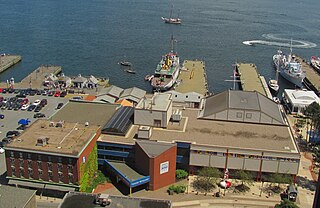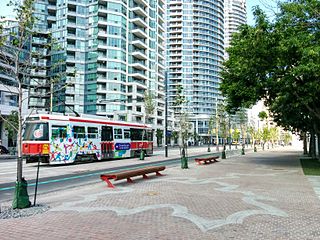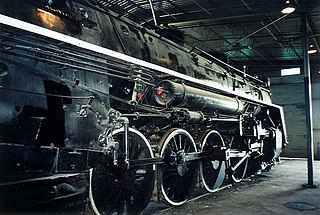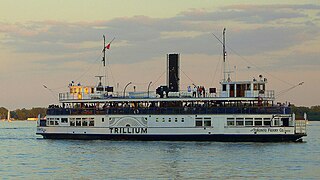
The Maritime Museum of the Atlantic is a maritime museum located in downtown Halifax, Nova Scotia, Canada.

Harbourfront is a neighbourhood on the northern shore of Lake Ontario within the downtown core of the city of Toronto, Ontario, Canada. Part of the Toronto waterfront, Harbourfront extends from Bathurst Street in the west, along Queens Quay, with its ill-defined eastern boundary being either Yonge Street or York Street. Its northern boundary is the Gardiner Expressway. Much of the district was former water lots filled in during the early 1900s to create a larger harbour district. After shipping patterns changed and the use of the Toronto harbour declined, the area was converted from industrial uses to a mixed-use district that is mostly residential and leisure.

The Toronto waterfront is the lakeshore of Lake Ontario in the city of Toronto, Ontario, Canada. It spans 46 kilometres between the mouth of Etobicoke Creek in the west and the Rouge River in the east.

New Fort York, later the Stanley Barracks, is a former British and Canadian military base in Toronto, Ontario, Canada, located on the Lake Ontario shoreline. It was built in 1840–1841 to replace Toronto's original Fort York at the mouth of Garrison Creek as the primary military base for the settlement. Unlike the older fort, many of the new fort buildings were made with limestone instead of wood. A protective wall was planned for the new fort but was never built. The fort was used by the British army until 1870, and the Canadian military subsequently used the fort to train troops for the Second Boer War, World War I and World War II. It also trained one of the first regiments of the North-West Mounted Police. The Canadian military stopped using it after World War II and the fort was demolished in the 1950s. Only the Officers' Quarters building remains on the site.

Toronto Harbour or Toronto Bay is a bay on the north shore of Lake Ontario, in Toronto, Ontario, Canada. It is a natural harbour, protected from Lake Ontario waves by the Toronto Islands. Today, the harbour is used primarily for recreational boating, including personal vessels and pleasure boats providing scenic or party cruises. Ferries travel from docks on the mainland to the Islands, and cargo ships deliver aggregates and raw sugar to industries located in the harbour. Historically, the harbour has been used for military vessels, passenger traffic and cargo traffic. Waterfront uses include residential, recreational, cultural, commercial and industrial sites.

Ned Hanlan is a steam-powered tugboat that operated in Toronto Harbour in Toronto, Ontario, Canada. The tugboat entered service in 1932 and was retired in 1967. She was then put on display at Exhibition Place. She was moved in 2012 to Hanlan's Point on the Toronto Islands; she is named after champion rower Ned Hanlan.

The Toronto Island ferries connect the Toronto Islands in Lake Ontario to the mainland of Toronto, Ontario, Canada. The main city-operated ferry services carry passengers (all) and commercial vehicles (some) from the Jack Layton Ferry Terminal at the foot of Bay Street to three docks on the islands. Private motor vehicles are not carried. The ferry operated by PortsToronto carries passengers and vehicles to Billy Bishop Toronto City Airport on the island from the foot of Eireann Quay. Additional private ferries carry passengers to various island boat clubs. Ferry services to the islands began in 1833, and the Toronto Island Ferry Company began in 1883.

Queens Quay is a prominent street in the Harbourfront neighbourhood of Toronto, Ontario, Canada. The street was originally commercial in nature due to the many working piers along the waterfront; parts of it have been extensively rebuilt in since the 1970s with parks, condominiums, retail, as well as institutional and cultural development.

The Kingston railway station is an inter-city passenger rail station in Cataraqui, Kingston, Ontario, Canada. It is served by Via Rail trains running from Toronto to Ottawa or Montreal, along the Corridor route. It is located on John Counter Boulevard, northeast of Princess Street and north-west of downtown Kingston.

Queen's Quay Terminal is a condominium apartment, office and retail complex in the Harbourfront neighbourhood in Toronto, Ontario, Canada. It was originally built in 1927 as a marine terminal with office, warehouse and cold-storage facilities. When shipping to Toronto declined in the 1960s and 1970s, the building was bought by the Government of Canada to be repurposed along with a section of the industrial waterfront. The Terminal Building itself was rebuilt in the 1980s with the addition of four floors of residential above the original facility, which was converted into retail and office uses. The cold storage wing was demolished and its plant building became The Power Plant gallery and Harbourfront Centre Theatre.

Downtown Toronto is the main central business district of Toronto, Ontario, Canada. Located entirely within the district of Old Toronto, it is approximately 16.6 square kilometres in area, bounded by Bloor Street to the northeast and Dupont Street to the northwest, Lake Ontario to the south, the Don Valley to the east, and Bathurst Street to the west. It is also the home of the municipal government of Toronto and the Government of Ontario.

The Halifax Waterfront Boardwalk is a public footpath located on the Halifax Harbour waterfront in Halifax, Nova Scotia, Canada.

The Confederation type was a large locomotive type with a 4-8-4 wheel arrangement used on Canadian railroads. Most were built by the Montreal Locomotive Works (MLW) in Montreal, Quebec, and the Canadian Locomotive Company (CLC) in Kingston, Ontario, for the Canadian National Railway (CNR). The "Confederation" type was later given the more common designation "Northern" type. They were the backbone of the CNR locomotive fleet from the 1930s to the 1950s. Eight locomotives of this type have been preserved from the CNR and 2 CPR fleets.
Maple Leaf Mills Silos was one of two silo or grain elevator complexes that were built in the area between Spadina Quay and Maple Leaf Quay, on Toronto Harbour, in Toronto, Ontario, Canada. It was one of three "monumental" silo complexes that dominated the city's waterfront.

Canadian National 6213 is a preserved 4-8-4 steam locomotive on static display in Toronto, Ontario, Canada at the Toronto Railway Museum (TRM) on the lands of the former CPR John St. Roundhouse. It was on active duty until 1959 and was donated by Canadian National Railway (CNR) to the City of Toronto government in 1960. It was on display at Exhibition Place until 2009 when it was moved to its current location.

Harbourfront Centre is a key cultural organization on the waterfront of Toronto, Ontario, Canada, situated at 235 Queens Quay West. Established as a crown corporation in 1972 by the Government of Canada to create a waterfront park, it became a non-profit organization in 1991. Funding comes from corporate sponsors, government grants, individual donors and entrepreneurial activities. Harbourfront Centre has a seating capacity of 2,000.

Trillium is a side wheeler ferry operated by the City of Toronto Parks, Forestry and Recreation, in Toronto, Ontario, Canada. Now 112 years old, she is one of several Toronto Island ferries operating between the Jack Layton Ferry Terminal at Bay Street and Queens Quay and three landing points on the Toronto Islands. She is the last sidewheel-propelled vessel on the Great Lakes.

The Marine Museum of the Great Lakes is a museum dedicated to marine history in the Great Lakes. It is located at 55 Ontario St. in Kingston, Ontario, which is also a designated National Historic Site of Canada.
The Wheelhouse Maritime Museum (WMM) was a maritime museum in Ottawa, Ontario, Canada. It opened officially on Monday, February 1, 1965 by the Underwater Society of Ottawa.. The Wheelhouse Maritime Museum was open to the public on Sunday afternoons from 1 to 5 p.m., and on Tuesdays and Thursdays evenings between 7 and 9 p.m. From February 1, 1965 until it closed in 1976, the Museum was housed in the top-storey of 218 Cumberland Street in Ottawa.

















